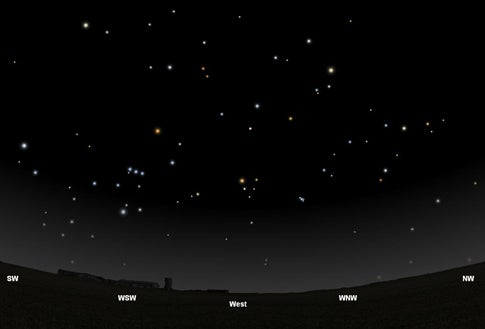The international star-counting activity known as GLOBE at Night from March 8-21 in two flavors: the “classic” GLOBE at Night exercise that anyone can have fun doing with their unaided eyes, and a new effort to obtain precise measurements of urban dark skies using digital sky-brightness meters.
The GLOBE at Night 2007 program is intended to build upon the worldwide participation sparked by the first GLOBE at Night campaign in March 2006. This inaugural effort drew more than 18,000 citizen-scientist participants in all 50 U.S. states and 96 countries worldwide, who submitted nearly 4,600 observations of the darkness of their local night skies during the 10-day event. The program is designed to aid teaching about the impact of artificial lighting on local environments, and the ongoing loss of a dark night sky as a natural resource for much of the world’s population.
The classic GLOBE at Night program directs students, families, and the general public how to observe and record the number of stars visible in the constellation Orion, as seen from different locations. Observers report their results online by comparing their view of Orion with a set of template images on the program’s Web site, which shows the number of stars in the constellation for a range of visibilities from bright skies to very dark.
In the process of discussing the results of this first campaign with educators and the professional astronomy community, GLOBE at Night staff from the National Optical Astronomy Observatory (NOAO) learned about a relatively new, low-cost digital sky-quality meter manufactured by Unihedron of Ontario, Canada. This meter takes a direct measurement of the integrated sky brightness across a wide swath of the night sky.
NOAO has received funding from the National Science Foundation to purchase about 130 of these Unihedron meters and related materials to share with educators in Arizona, California, Hawaii, Massachusetts, New Mexico, Nevada, New Jersey, Virginia, several other states, 19 small science centers, and the country of Chile, where NOAO has a major observatory. A coordinator at each site will instruct local educators in the proper use of the meters and develop a plan to share them as widely as possible during the 13-day window. The local teams are expected to pool their data for regional analysis, and to share the results with their schools and local policymakers.
“We hope to locate and preserve safe, dark locations within towns and cities in these areas, and make comparisons between cities,” says Dr. Stephen Pompea, manager of science education at NOAO. “We may uncover some urban oases that are untapped resources for the local community, or areas that could become a public asset if they had more efficient lighting.”
http://www.globe.gov/globeatnight










